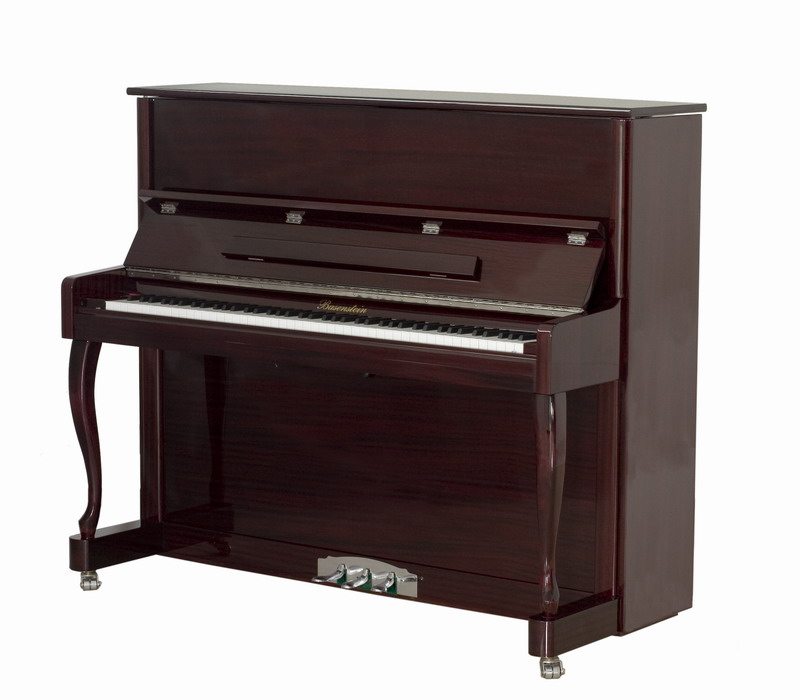
The best part of a vertical piano is, of course, how much smaller it is than a horizontal piano. If you have a horizontal in your house, it pretty much demands its own room. Upright pianos, however, can fit inside any room and enhance it, rather than dominating it.
So, if you’re interested in buying a piano but don’t have the floor space for a large horizontal, here’s a buyer’s guide to vertical pianos so you know what to look for!
Types of Upright Pianos
There are four types of vertical piano. There are two main differences between them: the size, and the keys’ action. In general, the larger a piano is, the better it will sound because it has longer strings and a larger soundboard. “Action” describes how pressing the keys causes the strings to be struck. It can be direct, when the key directly triggers the hammer, or indirect.
- Spinet Pianos: Spinets are the smallest of the upright pianos, generally only around 36-38 inches high. Unfortunately, due to their small size, they tend to have a weak sound. Further, to fit a full keyboard into that small space, they use a complex indirect action that tends to limit the responsiveness of the keys. In general, only buy a spinet if you’re on a tight budget or only have a small amount of floor space.
Console Pianos: Consoles are a bit larger than a spinet, around 40-44 inches high, and they’re the smallest model of piano that features a direct action behind the keys. Consoles are among the most popular upright pianos, and come in a huge variety of styles and designs. If cost is a factor, investigate console pianos first.
- Studio Pianos: Studios are the next biggest, 45-48 inches high. The additional space allows them to have a richer sound, and they’re frequently found in music schools and recording studios. A well-maintained studio piano can sound beautiful for decades. (As my grandmother proved!)
- Upright Pianos: While “vertical” and “upright” are often used interchangeably, a proper Upright Piano is defined as the largest of the vertical pianos. With 50-60 inches of external height, they have room to have strings that rival full grand pianos. While a top-of-the-line horizontal will always be the king of pianos, a good upright can give them a run for their money.
Buying Tips for Upright Pianos
Buying a piano is a true investment, and needs to be treated as such. Here are a few things to watch out for when buying:
- Check the action of the keys. Vertical pianos generally use springs to return the
hammers to their resting place, making them more prone to damage. Test the keys and make sure they all sound and return properly.
- Look inside for wear and tear. Watch for cracks or warps in the framework, as these can hamper the sound quality. Also beware of improper repairs such as unlevel tuning pins and different replacement parts, which should suggest the instrument has been poorly maintained.
- Check the tuning. If possible, bring a tuning fork or a recorder to check the tuning. The instrument will have to be re-tuned if you buy it, but if it’s not tuned in the first place, that’s a big warning sign.
- Look for overstrung models. Some vertical pianos string the bass keys diagonally above the treble strings. These have better sound and should be your first choice.
Finally, if any of our readers have any piano-buying tips of their own, we’ve love to hear them. Share with the world!







 Console Pianos: Consoles are a bit larger than a spinet, around 40-44 inches high, and they’re the smallest model of piano that features a direct action behind the keys. Consoles are among the most popular upright pianos, and come in a huge variety of styles and designs. If cost is a factor, investigate console pianos first.
Console Pianos: Consoles are a bit larger than a spinet, around 40-44 inches high, and they’re the smallest model of piano that features a direct action behind the keys. Consoles are among the most popular upright pianos, and come in a huge variety of styles and designs. If cost is a factor, investigate console pianos first. hammers to their resting place, making them more prone to damage. Test the keys and make sure they all sound and return properly.
hammers to their resting place, making them more prone to damage. Test the keys and make sure they all sound and return properly.